All Dryers Are Customized
Engineers available to offer overseas service
All Year Round After Sale Hotline
Free Remote Technical Support and Train
Warranty: 1 Year
Certification: ISO9001
Application: Animal Feed, Distillery Grains, Fermentation grains, Spent Grains, Spent tea, Silage, Corn Silage, Organic feed, Active feed, Active Bacteria Feed
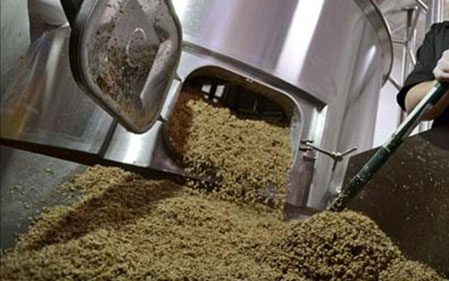
Before Drying
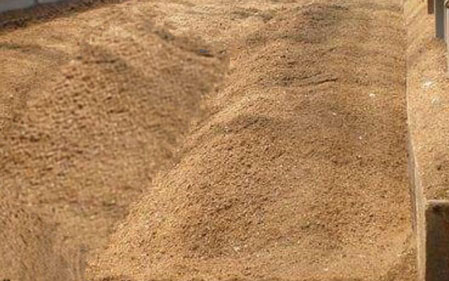
After Drying
Silage is a type of fodder made from green foliage crops which have been preserved by acidification, achieved through fermentation. It can be fed to cattle, sheep and other such ruminants (cud-chewing animals). The fermentation and storage process is called ensilage, ensiling or silaging. Silage is usually made from grass crops, including maize, sorghum or other cereals, using the entire green plant (not just the grain). Silage can be made from many field crops, and special terms may be used depending on type: oatlage for oats, haylage for alfalfa (haylage may also refer to high dry matter silage made from hay).
The silage-making process is commonly divided in 4 phases: (1) the initial aerobic phase in the silo immediately after harvest, (2) the fermentation phase, (3) the stable storage phase in the silo, and (4) the feed-out phase when the silo feed face is open and the material is exposed to air immediately before, during, and after its removal from the silo. Dry matter should be taken care and quality changes occur during each of these stages of the ensiling process, try to maintain the quality of the as fed product.
The purpose of animal feed drying is to remove the excess water from the feedstock for easy to pack, transport, store, process and use. And the most importance is keep the silage, DDGS, distiller grain nutrients during the drying process. We designed the 3 cylinder multi loop rotary drum dryer with "low temperature and large air volume" and automatically distributed the different air volume into 3 different cylinder to make sure its proteins, that means the temperature will not too high inside the dryer and we can adjust the hot air volume to control it flexibly. Each stage of the feed dregs dryer is equipped with an outlet to discharge water vapor at any time. In the drying process, the temperature in each stage of the dryer can be adjusted by the hot air control device, so that the material is always in an ideal drying environment, with no loss of nutrition, good color of the finished product, high heat utilization rate and low production cost.
The feed dregs dryer produced by the ZJN company uses hot air as the drying medium. The high humidity materials are firstly lifted and scattered by the feeding plate in the primary dryer, and then most of the moisture is quickly removed through the effect of high temperature hot air. Then the material is sent into the secondary dryer under the action of the special push plate. The drying process of the secondary dryer has a long stroke and relatively low temperature, so the material does a lot of back and forth movement here. Finally, the material automatically enters the three-stage dryer, and moves in the same direction with the low-temperature hot air, and is dried at low temperature. After three-stage drying, the material is discharged from the end of the three-stage dryer.
This drying equipment rotary drum dryer can also be used for drying forage, distiller’s grain, cassave residues/pulp, corn pulp, potato dregs, soy sauce residue, soybean wastes, fruit pomace, zymophyte dregs etc. The finished production is very good raw material of organic feed for animals.
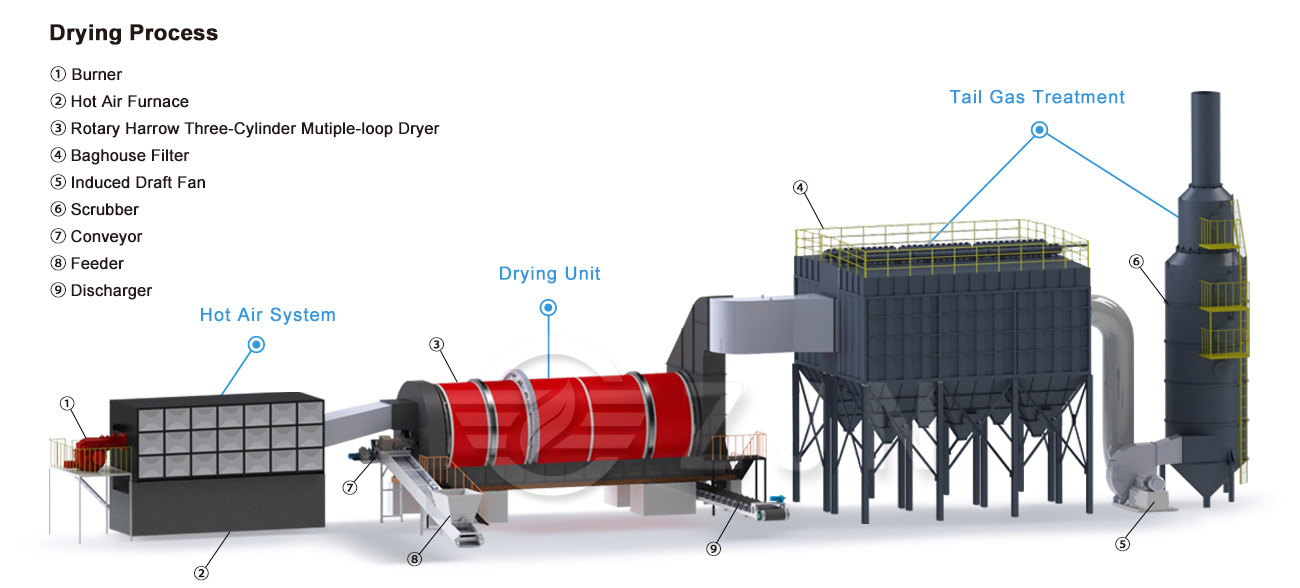
Grains and dregs are the surplus by-products produced in the production process of food or agricultural products processing, wine making and other industries, which are rich in material resources. According to the data statistics, the annual production of dregs in China is on the rise. If it is not handled in time, it is not only easy to ferment, rot, stink, breed mosquitoes, cause serious pollution to the environment, but also increase the production cost of enterprises. However, due to the rich organic matter, nitrogen, phosphorus, potassium and other mineral trace elements needed for crop production, as well as a large number of carbohydrates, crude protein, crude fat and crude fiber, it is very suitable for livestock feed.
The dregs dryer can quickly dry the materials with moisture content of about 80% to about 10%, greatly reducing the moisture content in the materials, reducing the volume of materials, and facilitating the subsequent transportation and storage. The materials dried by the dregs dryer can be further recycled, which can not only turn industrial waste into treasure, but also reduce environmental pollution, and improve the added value of dregs products
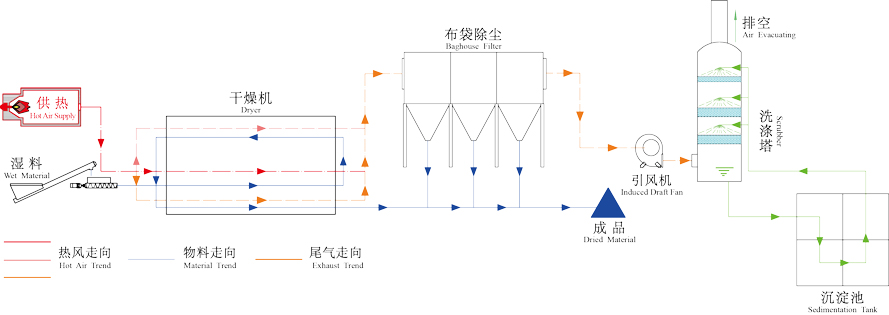
The structure design of the dregs dryer is reasonable, which is mainly composed of hot blast stove, feeding device, dryer body, discharging device, induced draft fan, dust removal equipment, power distribution cabinet, etc.
Its technological process: hot blast stove is the place to produce heat energy. The fuel is added into the hot blast stove to produce high-temperature heat medium through combustion, which provides continuous and stable heat for the main body of the dryer. Then, the feeding device (belt conveyor, seal scraper conveyor or screw conveyor) evenly and continuously sends the materials into the dryer. The heat exchange between the material and the high-temperature heat medium is carried out inside the cylinder, so that the moisture in the material is evaporated, and the material changes from high humidity and high viscosity to non humidity and non viscosity. The materials meeting the drying requirements are transported out through the discharging device for unified packaging and loading. The flue gas, dust and other gases generated in the drying process are transported to the dust removal equipment through the induced draft fan for purification, filtration and dust reduction, so as to achieve the gas emission standard. The whole drying production line is integrated to complete the drying of materials.
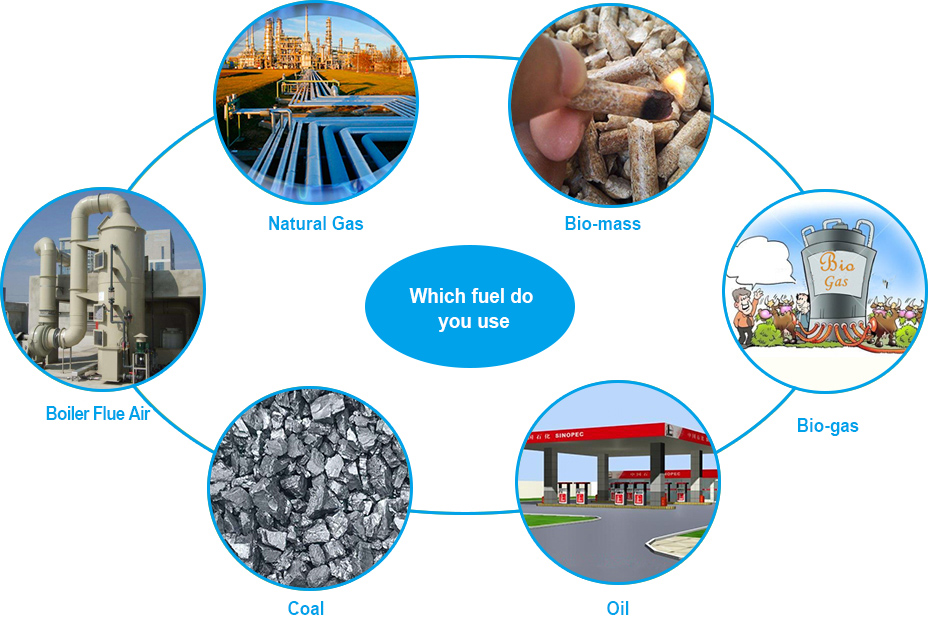
We have different hot air generating device for you. According to your Heat Source, no matter it is natural gas, bio-gas, coal, oil, bio-mass fuel or others, we match furnace, chamber, burner etc to be most suitable. What's more, the boiler flue gas can also be used as heat.
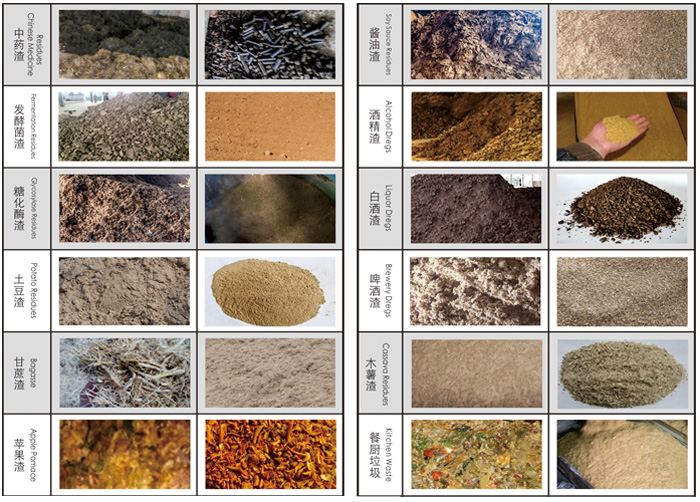
Brewer's grains (grains), alcohol distillers' grains (residue), alcohol dregs, potato dregs, potato dregs, cassava dregs, starch dregs, medicine dregs, vinegar dregs, soy sauce dregs, penicillin dregs, antibiotic dregs, western medicine residue, saccharifying enzyme dregs, fermented bacteria dregs, sugar residue, algal dregs, tea residue, sugar dregs, sugarcane bagasse, apple pomace, pear residue, tomato dregs, fermented feed, palm residue, coconut peat, coco coir pith, sugar beet pulp, maize silage, corn silage, cassava starch, alcohol plant projects alcohol distillery supplier's all kinds of grain, DDGS,bean dregs etc
It can be widely used in breweries, feed factories, pharmaceutical factories, starch factories, food processing plants and other industries.
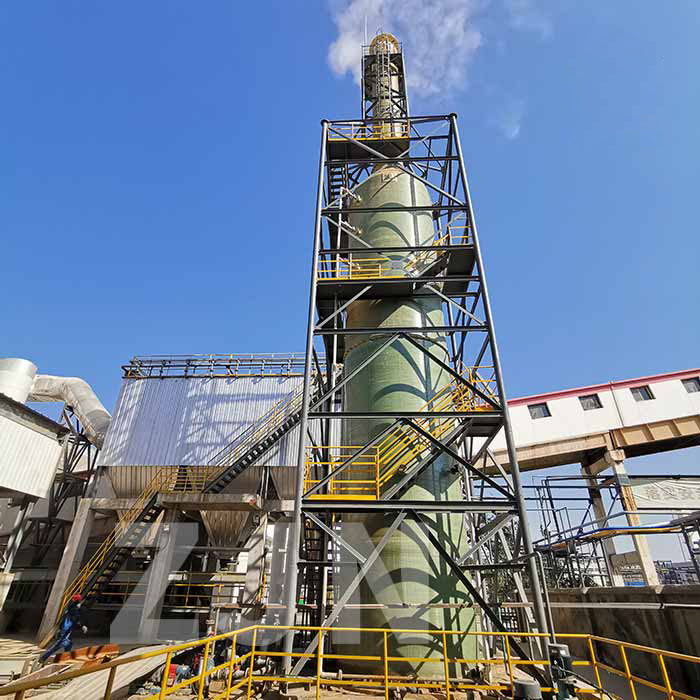
Scrubber
Scrubber systems (e.g. chemical scrubbers, gas scrubbers) are a diverse group of air pollution control devices that can be used to remove some particulates and/or gases from industrial exhaust streams.
The exhaust gases of combustion may contain substances considered harmful to the environment, and the scrubber may remove or neutralize those. A wet scrubber is used for cleaning air, fuel gas or other gases of various pollutants and dust particles. Wet scrubbing works via the contact of target compounds or particulate matter with the scrubbing solution. Solutions may simply be water (for dust) or solutions of reagents that specifically target certain compounds.
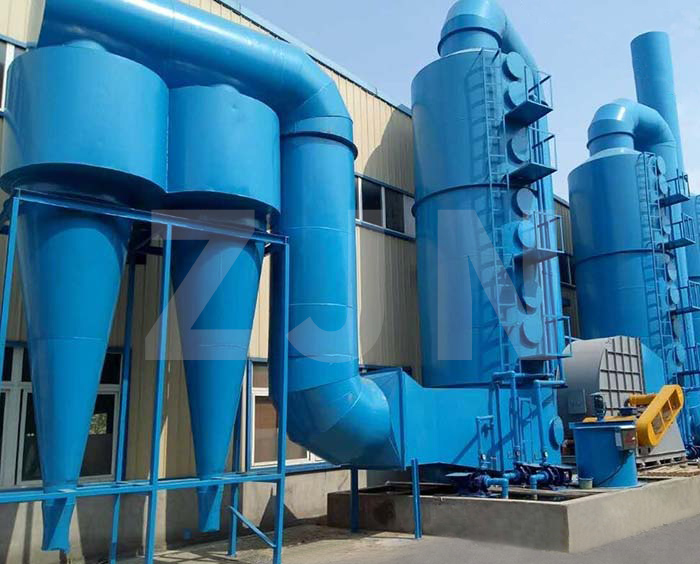
Cyclone Dust Collector
Centrifugal cyclone dust collector, the dust will be separated and recovered in the drying system, through the dry tail gas dust purification device of a cyclone dust collector, suitable for high dust concentration, large dust particles of exhaust gas dust removal operations, the dust collector has a simple structure, stable and reliable operation, long service life, and other characteristics.
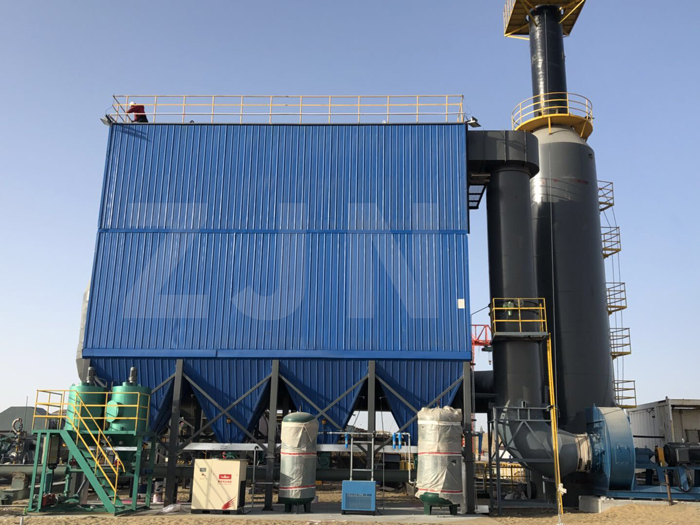
Baghouse
A bag house, also known as a bag house filter, bag filter, or fabric filter is an air pollution control device and dust collector that removes particulates or gas released from commercial processes out of the air.
Most baghouses use long, cylindrical bags (or tubes) made of woven or felted fabric as a filter medium. For applications where there is relatively low dust loading and gas temperatures are 250 °F (121 °C) or less, pleated, non woven cartridges are sometimes used as filtering media instead of bags.
Bag houses are very efficient particulate collectors because of the dust cake formed on the surface of the bags. The fabric provides a surface on which dust collects through the following four mechanisms:
Inertial collection – Dust particles strike the fibers placed perpendicular to the gas-flow direction instead of changing direction with the gas stream.
Interception – Particles that do not cross the fluid streamlines come in contact with fibers because of the fiber size.
Brownian movement – Sub micrometre particles are diffused, increasing the probability of contact between the particles and collecting surfaces.
Electrostatic forces – The presence of an electrostatic charge on the particles and the filter can increase dust capture.
A combination of these mechanisms results in formation of the dust cake on the filter, which eventually increases the resistance to gas flow. The filter must be cleaned periodically.
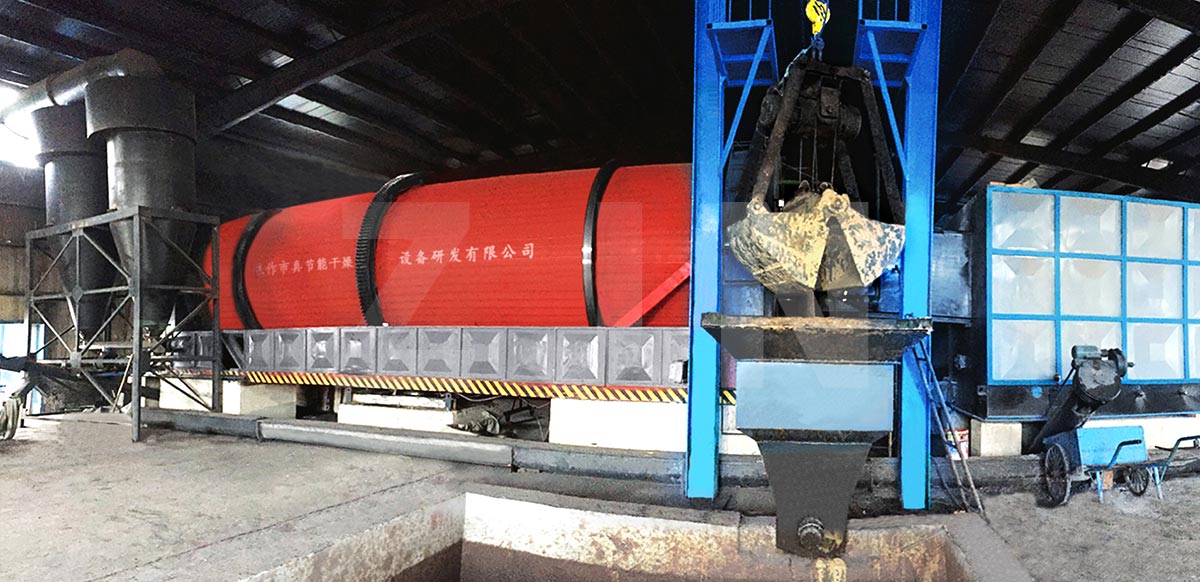
1. Equipment structure
The equipment adopts a three sleeve structure, that is, three cylinder sleeves of different sizes are embedded together, which reduces the length of the equipment, reduces the actual floor area, and greatly increases the storage space inside the cylinder and increases the processing capacity of the equipment.
2. Equipment operation
Fully automatic operation, high degree of intelligence, simple and convenient operation, 24-hour continuous operation.
3. Heat distribution
In the process of drying, the temperature and air volume can be adjusted according to the moisture content of the dregs in different stages.
4. Equipment material
The equipment is made of materials with high temperature resistance, corrosion resistance and wear resistance. The equipment has good quality, stable performance and low failure rate. Greatly extend the service life of the equipment.
5. Energy saving and environmental protection
The whole production process of the system is tightly sealed, which can effectively reduce gas leakage and heat dissipation, and has good energy saving and environmental protection performance.
6. Heat source range
The heat source of the equipment can be gas, coal, electricity, oil, biomass particles, boiler flue gas waste heat resources and steam, etc.
7. The finished product is controllable
The quality of the dried dregs is even, and the state and size of the dregs can be adjusted according to the user's requirements to facilitate the next use.
Copyright ©2022 by Jiaozuo ZJN Environmental Protection Equipment Technology Co., Ltd.